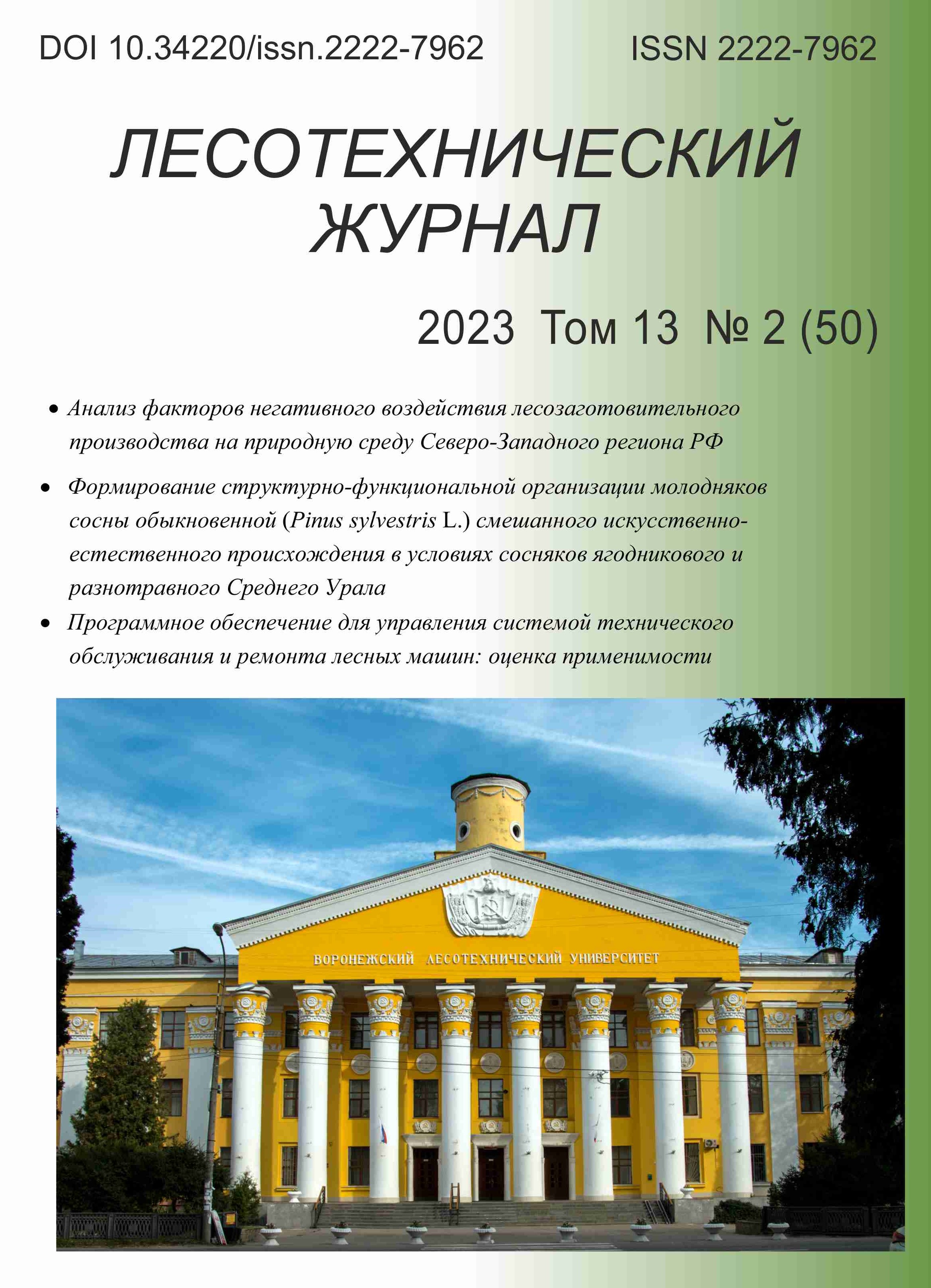Voronezh, Voronezh, Russian Federation
Voronezh, Russian Federation
Voronezh, Russian Federation
Voronezh, Voronezh, Russian Federation
UDK 630 Лесное хозяйство. Лесоводство
The results of a study of birch test cultures obtained by different methods of ex situ pollination and introduced into culture in vitro are presented. To identify the phenotypic, cultural and cytological characteristics of two birch species naturally growing in the Central Black Earth Region - silver birch (diploid) and downy birch (tetraploid), test cultures of seed origin F1 and F2 were specially created. The article presents data on phenotypic (growth in height in the juvenile and reproductive periods of ontogeny), genetic selection (seed propagation system) variability and some characteristics of the introduction of F1 seed progeny of breeding forms of local birch species into in vitro culture. To predict the growth characteristics of seed progeny of breeding forms of local birch species obtained by different methods of pollination - self-pollination and open pollination at different stages of ontogeny (at the age of 2 and 10 years), a statistical processing of the feature of growth in height of families was carried out using the rank Spearman's correlation coefficient ρ. Species specificity was shown in response to different pollination methods, morphogenic activity of self-fertile and self-sterile forms of these birch species on a nutrient medium ½ MC + 6-benzylaminopurine 1 mg/l, primary shoot formation of explants and regenerative capacity in these species, the nature of morphogenesis (formation of the main escape). For the polyploid species (downy birch), a higher level of self-fertility was established, as well as a more intensive growth of shoots in height than for drooping birch; primary explants in the former had a different character of morphogenesis (there was a joint initiation of the main shoot with adventitious ones) than in silver birch (formation of the main shoot), which indicates a greater adaptive potential for polyploid species and their greater opportunities for inclusion in genetic breeding experiments and obtaining valuable breeding forms.
Betula pendula Roth., Betula pubescens Ehrh., self-fertility, self-sterility, juvenile age, in vitro culture, polyploidy, primary explant, multiplication factor, metaphase plate
1. Staniszewski P., Moskalik T., Bilek M., Szwerc W., Kocjan R., Tomusiak R., Osiak P. The effect of tree age, daily sap volume and date of sap collection on the content of minerals and heavy metals in silver birch (Betula pendula Roth) tree sap / PLOS ONE. 2020; 15(12):1-19. DOI:https://doi.org/10.1371/journal.pone.0244435. EDN: https://elibrary.ru/WJJJZN
2. Bona A., Kulesza U., Jadwiszczak K. A. Clonal diversity, gene flow and seed production in endangered populations of Betula humilis Schrk. Tree Genetics & Genomes. 2019;15;4: 50. - DOI: https://doi.org/10.1007/s11295-019-1357-2.
3. Medvedeva S. O., Cherepanova O. E., Tolkach O. V., Ponomarev V. I., Malosieva G. V. Dannye po izmenchivosti regiona ITS 1-2 yadernoy ribosomal'noy DNK Betula turkestanica, B. tianschanica, B. procurva. Lesohozyaystvennaya informaciya. 2023;2: 127-135. DOI 10.24419/ LHI.2304-3083.2023.2.10. DOI: https://doi.org/10.24419/LHI.2304-3083.2023.2.10; EDN: https://elibrary.ru/HQNQNH
4. Bona A., Petrova G., Jadwiszczak K.A. Unfavourable habitat conditions can facilitate hybridisation between the endangered Betula humilis and its widespread relatives B. pendula and B. pubescens. Plant Ecology and Diversity. 2018;11(3): 295-306. doi:https://doi.org/10.1080/17550874.2018.1518497. EDN: https://elibrary.ru/CRUGKE
5. Anamthawat-Jónsson K., Karlsdóttir L., Thórsson Æ.T., Jóhannsson M. H. Naturally occurring triploid birch hybrids from woodlands in Iceland are partially fertile. New Forests. 2021;52: 659-678. doi: https://doi.org/10.1007/s11056-020-09816-z. EDN: https://elibrary.ru/LGXHMX
6. Zhang H., Ding J., Holstein N., Wang N. Betula mcallisteri sp. nov. (sect. Acuminatae, Betulaceae), a new diploid species overlooked in the wild and in cultivation, and its relation to the widespread B. luminifera. Front. Plant Sci. 2023; 14: 1113274. doi:https://doi.org/10.3389/fpls.2023.1113274.
7. Belton S., Cubry P., Fox E., Kelleher C. T. Novel Post-Glacial Haplotype Evolution in Birch - A Case for Conserving Local Adaptation. Forests. 2021;12, 1246. doi: https://doi.org/10.3390/f120912. DOI: https://doi.org/10.3390/f12091246; EDN: https://elibrary.ru/QNKTBB
8. Anamthawat-Jónsson K. Hybrid introgression: the outcomes of gene flow in birch. Science Asia. 2019;45: 203-211. doi:https://doi.org/10.2306/scienceasia1513-1874. DOI: https://doi.org/10.2306/scienceasia1513-1874.2019.45.203; EDN: https://elibrary.ru/EVRSEJ
9. Anamthawat-Jónsson K., Karlsdóttir L., Thórsson A.T., Hallsdóttir M. Microscopical palynology: Birch woodland expansion and species hybridisation coincide with periods of climate warming during the Holocene epoch in Iceland. J Microsc. 2023;291(1): 128-141. doi:https://doi.org/10.1111/jmi.13175. Epub 2023 Feb 28. PMID: 36779661. EDN: https://elibrary.ru/TLXFCM
10. Singatullin I. K., Shayhraziev Sh. Sh., Glushko S. G. Estestvennoe vozobnovlenie berezy povisloy (Betula pendula Roth) v lesostepnoy zone respubliki Tatarstan. Lesnoy vestnik. Forestry Bulletin. 2021;25(5): 14-21. doi:https://doi.org/10.18698/2542-1468-2021-5-14-21. URL: https://www.elibrary.ru/item.asp?id=47276762. EDN: https://elibrary.ru/WMCOEA
11. Polimorfizm i bioraznoobrazie lesoobrazuyuschih porod v iskusstvennyh i estestvennyh nasazhdeniyah Central'noy lesostepi : monogr. / I. Yu. Isakov, V. I. Mihin, G. S. Sidorov [i dr.]. - Voronezh, 2021. - 158 s. - URL: https://elibrary.ru/item.asp?id=48044502. EDN: https://elibrary.ru/DBAGBF
12. Popov, V. K. Berezovye lesa Central'noy lesostepi Rossii. - Voronezh : Izd-vo Voronezh. gos. lesotehn. akademii. 2003. - 424 s. URL: https://elibrary.ru/item.asp?id=19505353. EDN: https://elibrary.ru/QKVSSV
13. Mihin V. I., Mihina E. A. Osobennosti formirovaniya zaschitnyh nasazhdeniy iz berezy povisloy v Central'noy lesostepi Rossii. Lesotehnicheskiy zhurnal. 2019;9(4): 41-49. - URL: https://elibrary.ru/item.asp?id=41748521. DOI: https://doi.org/10.34220/issn.2222-7962/2019.4/5; EDN: https://elibrary.ru/FTFCYS
14. Isakov I. Yu. The effect of a single inbreeding on the growth and development of fast-growing tree species, Betula pendula and Betula pubescens. IOP Conf. Ser.: Earth Environ. Sci. 2021;875 012014. doi:https://doi.org/10.1088/1755-1315/875/1/012014. EDN: https://elibrary.ru/PFBTTJ
15. Yancheva S., Kondakova V. Plant tissue culture technology: Present and future development. Bioprocessing of plant in vitro systems. Cham, Springer. 2018; 39-63. doi:https://doi.org/10.1007/978-3-319-54600-1_16. EDN: https://elibrary.ru/WLVEFH
16. Tret'yakova I. N., Pak M. E., Oreshkova N. V., Padutov V. E. Regeneracionnaya sposobnost' kletochnyh liniy listvennicy sibirskoy v kul'ture in vitro. Izvestiya Rossiyskoy akademii nauk. Seriya biologicheskaya. 2022; 6: 585-596. DOI:https://doi.org/10.31857/S1026347022050195. URL: https://www.elibrary.ru/item.asp?id=49297220. EDN: https://elibrary.ru/UDKRJO
17. Vetchinnikova L. V., Titov A. F. Karel'skaya bereza - unikal'nyy biologicheskiy ob'ekt. Uspehi sovremennoy biologii. 2019; 139(5): 419-433. DOI:https://doi.org/10.1134/S0042132419050107. URL: https://www.elibrary.ru/item.asp?id=39796762. EDN: https://elibrary.ru/HZIJGN
18. Mashkina O. S., Tabackaya T. M., Vnukova N. I. Tehnologiya dolgosrochnogo hraneniya v kul'ture in vitro cennyh genotipov berezy i vyraschivanie na ee osnove posadochnogo materiala. Biotehnologiya. 2019; 35(3): 57-67. doi:https://doi.org/10.21519/0234-2758-2019-35-3-57-67. URL: https://www.elibrary.ru/item.asp?id=38304525. EDN: https://elibrary.ru/QVROFE
19. Tabackaya T. M., Mashkina O. S. Opyt dolgovremennogo hraneniya kollekcii cennyh genotipov berezy s ispol'zovaniem bezgormonal'nyh pitatel'nyh sred. Lesovedenie. 2020; (2): 147-161. DOI:https://doi.org/10.31857/S0024114820020084. URL: https://www.elibrary.ru/item.asp?id=42414256. EDN: https://elibrary.ru/TPNODN
20. Sedgwick P. Spearman's rank correlation coefficient. BMJ Clinical Research. 2018; 349: g7327. DOI:https://doi.org/10.1136/bmj.g7327.
21. Murashige T., Skoog F. A revised medium for rapid growth and bio assays with Tobacco tissue cultures. Physiol. Plantarum. 2018; 15(3): 473-497. DOI:https://doi.org/10.1111/j.1399-3054.1962.tb08052.x.
22. Mashkina O. S., Tabackaya T. M. Ocenka dlitel'no kul'tiviruemyh in vitro kollekcionnyh klonov ivy po dannym hromosomnogo analiza. Vestnik Voronezhskogo gosudarstvennogo universiteta. Seriya: Himiya. Biologiya. Farmaciya. 2023;2: 46-53. URL: https://www.elibrary.ru/item.asp?id=54070178. EDN: https://elibrary.ru/LLFCFO
23. Grodetskaya T., Evlakov P., Isakov I., Padutov V. The effect of drought on the expression of stress resistance genes in perspective forms of birch / IOP Conference Series: Earth and Environmental Science. International Forestry Forum "Forest ecosystems as global resource of the biosphere: calls, threats, solutions". 2020; 012039. DOIhttps://doi.org/10.1088/1755-1315/595/1/012039. EDN: https://elibrary.ru/FOUDIZ
24. Tikhomirova T. S., Krutovsky K. V., Shestibratov K. A. Molecular traits for adaptation to drought and salt stress in birch, oak and poplar species. Forests. 2023;14(1). Pp. 7. DOI:https://doi.org/10.3390/f14010007. EDN: https://elibrary.ru/UUKOIB
25. Vetchinnikova L. V., Titov A. F. Vliyanie kadmiya na gemmo- i rizogenez karel'skoy berezy. Fiziologiya rasteniy. 2022; 69(4): 408-416. DOI:https://doi.org/10.31857/S0015330322040194. URL: https://www.elibrary.ru/item.asp?id=48658983. EDN: https://elibrary.ru/QTKGXU
26. Gailis A., Samsone I., Šēnhofa S. et al. Silver birch (Betula pendula Roth.) culture initiation in vitro and genotype determined differences in micropropagation. New Forests. 2021;52;5: 791-806. DOI: https://doi.org/10.1007/s11056-020-09828-9. EDN: https://elibrary.ru/BWQZHP
27. Lebedev V. G., Shestibratov K. A. Shirokomasshtabnoe klonal'noe mikrorazmnozhenie drevesnyh lesnyh porod dlya zakladki lesnyh plantaciy // Biologiya kletok rasteniy in vitro i biotehnologiya : tezisy dokladov XI Mezhd. konf. (23-27 sentyabrya 2018, Minsk, Belarus'). - Belarus', 2018. - S. 126-127. URL: https://www.elibrary.ru/item.asp?id=36622494. EDN: https://elibrary.ru/SMVZST












